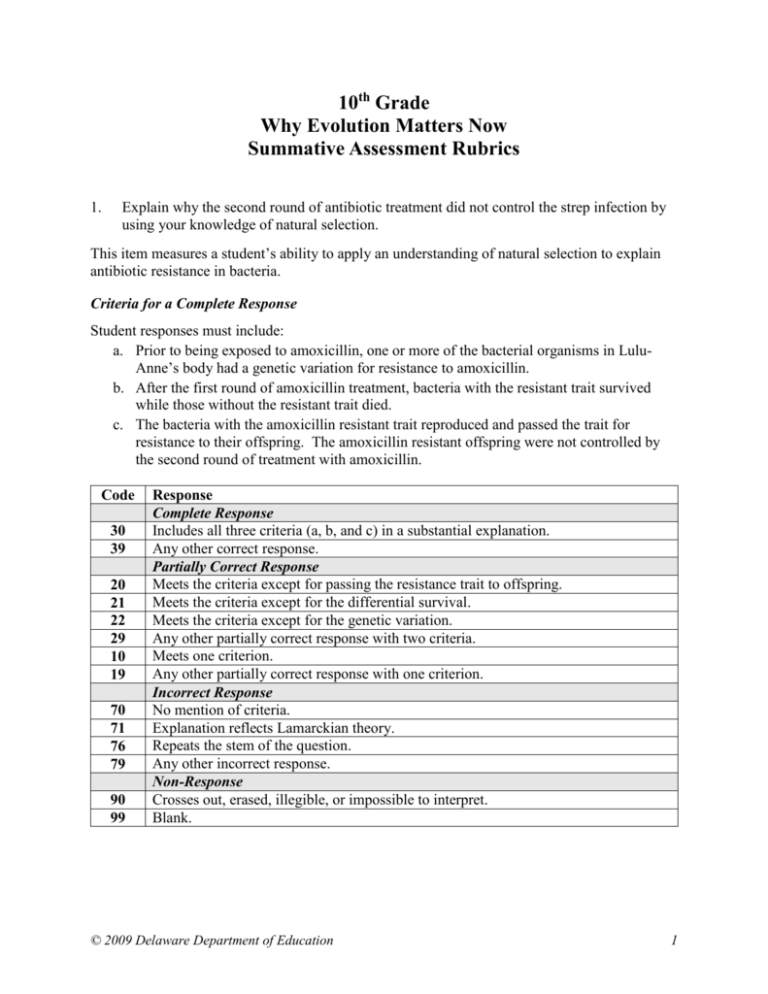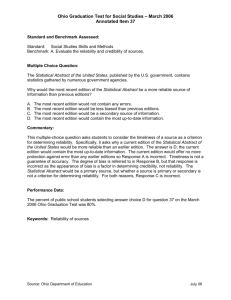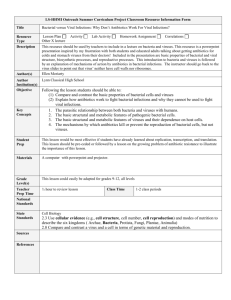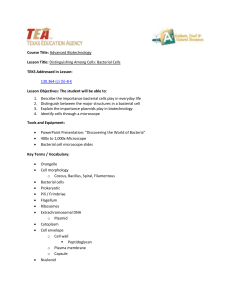Complete Response - Delaware Department of Education
advertisement

10th Grade Why Evolution Matters Now Summative Assessment Rubrics 1. Explain why the second round of antibiotic treatment did not control the strep infection by using your knowledge of natural selection. This item measures a student’s ability to apply an understanding of natural selection to explain antibiotic resistance in bacteria. Criteria for a Complete Response Student responses must include: a. Prior to being exposed to amoxicillin, one or more of the bacterial organisms in LuluAnne’s body had a genetic variation for resistance to amoxicillin. b. After the first round of amoxicillin treatment, bacteria with the resistant trait survived while those without the resistant trait died. c. The bacteria with the amoxicillin resistant trait reproduced and passed the trait for resistance to their offspring. The amoxicillin resistant offspring were not controlled by the second round of treatment with amoxicillin. Code 30 39 20 21 22 29 10 19 70 71 76 79 90 99 Response Complete Response Includes all three criteria (a, b, and c) in a substantial explanation. Any other correct response. Partially Correct Response Meets the criteria except for passing the resistance trait to offspring. Meets the criteria except for the differential survival. Meets the criteria except for the genetic variation. Any other partially correct response with two criteria. Meets one criterion. Any other partially correct response with one criterion. Incorrect Response No mention of criteria. Explanation reflects Lamarckian theory. Repeats the stem of the question. Any other incorrect response. Non-Response Crosses out, erased, illegible, or impossible to interpret. Blank. © 2009 Delaware Department of Education 1 2.a. Construct a connected line graph that illustrates changes in the bacteria population using data from the labeled drawings Plot time on the X-axis and the number of bacteria on the Y-axis. This item measures the student’s ability to represent the data on a graph. Criteria for a Complete Response: The students’ graphs must include correct or appropriate: a. Labels: title, labels for time in minutes on X-axis, and number of bacteria on Y-axis. b. Scaling of each axis. c. Data points connected with a line. Code 30 20 21 22 70 90 91 99 Response Complete Response Meets all three criteria. Partially Correct Response Meets two criteria but omits labels. Meets two criteria but incorrect scaling. Meets two criteria but data not connected with a line. Incorrect Response Makes an error on more than one criteria. Non-Response Crosses out, erases, illegible, or impossible to interpret. Graph is too small to interpret. Blank. © 2009 Delaware Department of Education 2 2.b. Describe what happened to the size of the bacteria population after the antibiotic was added. This item measures the student’s ability to interpret graphic information. Criterion for a Complete Response: 1. Student responds by indicating a decrease in the population, followed by an increase. Code 20 21 29 10 11 12 19 70 71 72 76 79 90 99 Response Complete Response Population decreased, then increased. Uses numerical data to show a decrease and then an increase (32-10-20). Any other correct response. Partially Correct Response Population size decreased only. Uses correct and incorrect numbers to compare populations. Correct numerical values listed but not described. Any other partially correct response. Incorrect Response Population size increased. Population size remained the same. Uses incorrect numerical data in explanation. Repeats the stem of the question. Any other incorrect response. Non-Response Crossed out, erased, illegible, or impossible to interpret. Blank. © 2009 Delaware Department of Education 3 3. Sometimes doctors treat patients with a particular bacterial infection with several different antibiotics simultaneously. This treatment is known as a “multi-drug cocktail.” a. What do you predict will happen to the bacteria population if a multi-drug cocktail is added (instead of amoxicillin) at 96 minutes? This item measures the student’s ability to explain how the persistence and re-emergence of many infectious disease organisms is due to their ability to develop resistance to antibiotics and other treatments through processes consistent with evolutionary theory. Criterion for a complete response: 1. Students respond by indicating that the bacterial population would be expected to drop to zero or at least a population number lower than the reduction caused by the amoxicillin treatment. Code 10 70 71 72 90 99 Response Complete Response Meets above criterion. Incorrect Response Predicts an increase in bacterial population. Predicts no change in the bacterial population. Any other incorrect response. Non-Response Crossed out, erased, illegible, or impossible to interpret. Blank. © 2009 Delaware Department of Education 4 3. Sometimes doctors treat patients with a particular bacterial infection with several different antibiotics simultaneously. This treatment is known as a “multi-drug cocktail.” b. Of the four choices below, select the graph which best represents your prediction. This item measures the student’s ability to select appropriate graphical data. Criterion for a Complete Response: 1. Student selects graph A to represent a decrease in the bacterial population after the multidrug cocktail was given. Code 10 70 90 99 Response Complete Response Selects graph A. Incorrect Response Selects any other graph. Non-Response Crossed out, erased, illegible, or impossible to interpret. Blank. © 2009 Delaware Department of Education 5 3. Sometimes doctors treat patients with a particular bacterial infection with several different antibiotics simultaneously. This treatment is known as a “multi-drug cocktail.” c. Compare your amoxicillin graph with your selected multi-drug cocktail graph. Explain what causes the difference in the bacterial population as illustrated in the graphs between t=96 minutes and t=144 minutes. This item measures the student’s ability to predict the outcome of the application of additional variables (antibiotics). Criteria for a Correct Response: a. Students conclude that no or few resistant bacteria should be left. b. Students add that this decrease results because, even though the bacterial population has evolved resistance to one antibiotic, it is unlikely to have evolved resistance to all the antibiotics in a multi-drug cocktail. Code 20 21 29 10 11 19 70 71 76 79 90 99 Response Complete Response Both criteria are mentioned. Both criteria are mentioned and includes description of one or more ways that antibiotics work. Any other correct response. Partially Correct Response Student correctly describes criterion a but not b. Student correctly described criterion b but not a. Any other partially correct answer. Incorrect Response No mention of either criteria. Explanation reflects Lamarckian theory. Repeats the stem of the question. Any other incorrect response. Non-Response Crossed out, erased, illegible, or impossible to interpret. Blank. © 2009 Delaware Department of Education 6








